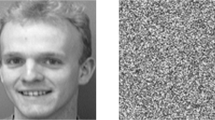Abstract
Recently, cancelable biometrics emerged as one of the highly effective methods of template protection. The concept behind the cancelable biometrics or cancelability is a transformation of a biometric data or extracted feature into an alternative form, which cannot be used by the imposter or intruder easily, and can be revoked if compromised. In this paper, we present a novel architecture for template generation in the context of situation awareness system in real and virtual applications. We develop a novel cancelable biometric template generation algorithm utilizing random biometric fusion, random projection and selection. Proposed random cross-folding method generate cancelable biometric template from multiple biometric traits. We further validate the performance of the proposed algorithm using a virtual multimodal face and ear database.








Similar content being viewed by others
Explore related subjects
Discover the latest articles, news and stories from top researchers in related subjects.References
Jain, A.K., Nandakumar, K., Nagar, A.: Biometric template security. EURASIP J. Adv. Signal Process. 2008, 579416 (2008)
Ross, A., Shah, J., Jain, A.K.: From template to image: reconstructing finger-prints from minutiae points. IEEE Trans. Pattern Anal. Mach. Intell. 29(4), 544–560 (2007)
Ross, A., Nandakumar, K., Jain, A.K.: Handbook of multibiometrics. Springer, New York (2006)
Down, M.P., Sands, R.J.: Biometrics: an overview of the technology, challenges and control considerations. J. Inf. Syst. Control 4, 53–56 (2004)
Alder, A.: Sample images can be independently restored from face recognition templates. Electr. Comput. Eng. 2, 1163–1166 (2003)
Maltoni, D., Maio, D., Jain, A.K., Prabhakar, S.: Handbook of fingerprint recognition. Springer, Berlin (2003)
Jain, A.K., Flynn, P., Ross, A.: Handbook of biometrics. Springer, New York (2007)
Feng, Y.C., Yuen, P.C., Jain, A.K.: A hybrid approach for generating secure and discriminating face template. IEEE Trans. Inf. Forensics Secur. 5(1), 103–117 (2010)
Paul, P.P., Gavrilova, M.: Multimodal cancelable biometrics. In: 12th IEEE International Conference on Cognitive Informatics and Cognitive Computing, pp. 43–50. IEEE xplore, Kyoto (2012)
Wang, P., Berwick, Pedrycz, Kinsner, Zhang, M., Gavrilova: Informatics and cognitive computing in year 10 and beyond. Int. J. Cogn. Inf. Nat. Intell. 5(4), 1–21 (2012)
Juels, A., Wattenberg, M.: A fuzzy commitment scheme. In: Proceedings of Sixth ACM Conference on Computer and Communication Security (1999)
Juels, A., Sudan, M.: A fuzzy vault scheme. In: IEEE International Symposium on Information Theory (2002)
Goh, A., Ngo, D.C.L.: Computation of cryptographic keys from face bio-metrics. In: 7th IFIP TC6/TC11 Conference on Communication and Multimedia Security (2003)
Ratha, N., Chikkerur, S., Connell, J., Bolle, R.: Generating cancelable finger-print templates. IEEE Trans. Pattern Anal. Mach. Intell. 29(4), 561–572 (2007)
Teoh, A., Ngo, D., Goh, A.: Biohashing: two factor authentication featuring fingerprint data and tokenised random number. Pattern Recognit. 37(11), 2245–2255 (2004)
Turk, M., Pentland, A.: Eigenfaces for recognition. J. Cogn. Neurosci. 3(1), 71–86 (1991)
Gavrilova, M., Monwar, M.: Fusing multiple matchers outputs for secure human identification. IJBM 1(3), 329–348 (2009)
Ahmadian, K., Gavrilova, M.: A multimodal biometric architecture for high-dimensional features. Vis. Comput. 29, 123–130 (2013)
Belhumeur, P.N., Hespanha, J.P., Kriegman, D.J.: Eigenfaces vs. Fisherfaces: recognition using class specific linear projection. EEE Trans. Pattern Anal. Mach. Intell. 19(7), 711–720 (1997)
Johnson, W.B., Lindenstrauss, J.: Extensions of Lipschitz mappings into a Hilbert space. In: International Conference on Modern Analysis and Probability (1984)
Pillai, J., Patel, V., Chellappa, R., Ratha, N.: Sectored random projections for cancelable iris biometrics. In: IEEE International Conference on Acoustics Speech and Signal Processing. pp. 1838–1841 (2010)
Achlioptas, D.: Database-friendly random projections. In: ACM SIGACT-SIGMOD-SIGART Symposium on Principles of Database Systems (2011)
Soliverez, C.E., Gagliano, E.: Orthonormalization on the plane: a geometric approach. Rev. Mex. J. Phys. 31(4), 743–758 (1985)
Phillips, J.P., Wechsler, H., Rauss, P.: The FERET database and evaluation procedure for face-recognition algorithms. Imag. Vis. Comput. 16(5), 295–306 (1998)
Sanderson, C., Paliwal, K.: Polynomial features for robust face authentication. IEEE Int. Conf. Imag. Process. 3, 997–1000 (2002)
Zhichun, M., Zhengguang, X., Yuan, L., Wang, Z.: A new technology of biometric identification-ear recognition. In: the 4th Chinese Conference on Biometric Recognition. Springer, Beijing (2003)
Tina, Y., Wang Y., Gavrilova, M.: A formal knowledge representation system for the cognitive learning engine. In: IEEE International Conference on Cognitive Informatics and Cognitive Computing. IEEE xplore, Banff (2011)
Samaria, F., Harter, A.: Parameterization of a stochastic model for human face identification. 2nd IEEE Workshop on Applications of Computer Vision. pp. 138–142. Sarasota (1994)
Matsumoto, T., Hirabayashi, M., Sato, K.: A vulnerability evaluation of iris matching. In: Proceedings of the Symposium on Cryptography and Information Security. Iwate (2004)
Matsumoto, T., Matsumoto, H., Yamada, K., Hoshino, S.: Impact of artificial “gummy” fingers on finger-print systems. In: Proceedings of SPIE, Optical Security and Counterfeit Deterrence Techniques IV. San Jose (2002)
Eriksson, A., Wretling, P.: How flexible is the human voice? A case study of mimicry. In: European Conference on Speech Technology. Rhodes (2007)
Kirillov, I.A., Metcherin, S.A., Klimenko, S.V.: Metamodel of shared situation awareness for resilience management of built environment. In: Proceedings of International Conference on Cyberworlds. IEEE xplore (2012)
Paul, P.P., Gavrilova, M.: A novel cross folding algorithm for multimodal cancelable biometrics. Int. J. Softw. Sci. Comput. Intell. 4(3), 21–38 (2012)
Monwar, M., Gavrilova, M.: A multimodal biometric system using rank level fusion approach. IEEE Transactions on Man, Systems and Cybernatics TMSC Part B, Special Issue on Cognitive Informatics and Cybernetics 39(5),867–878 (2009)
Monwar, M., Gavrilova, M.: Markov chain model for multimodal biometric rank fusion. Signal Imag. Video Process. 137–149 (2013)
Gavrilova, M., Ahmadian, K.: Dealing with biometric multi-dimensionality through novel chaotic neural network methodology. International Journal of Information Technology and Management, Inderscience, special issue on “Advances and Trends in Biometrics”, 11, 18–34 (2011)
Acknowledgments
Authors would like to acknowledge the support of NSERC, URGC Cybersecurity Seed Grant, and RFBR grant 11-07-00329 for partial funding of this project.
Author information
Authors and Affiliations
Corresponding author
Rights and permissions
About this article
Cite this article
Paul, P.P., Gavrilova, M. & Klimenko, S. Situation awareness of cancelable biometric system. Vis Comput 30, 1059–1067 (2014). https://doi.org/10.1007/s00371-013-0907-0
Published:
Issue Date:
DOI: https://doi.org/10.1007/s00371-013-0907-0




